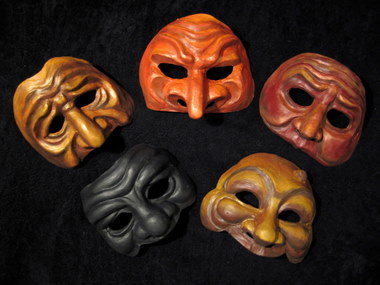A short discussion needs to be given to the difference between these Comedic masks (or Traditional Greek masks in general) and Commedia Dell’ Art masks. Prosperi noticed that the audience noticed a similarity to the masks of this ancient Greek Comedy and Commedia Dell’ Arte, but there is a major difference between the two. The masks of the Greek Comedy represent “characters, not stereotypes” (Prosperi 1982). This can be seen in the physical design of the masks as well. The Greek masks, as has been mentioned, are large and helmet-like. Prosperi mentions that they are “detailed in physiognomic design and have specific psychological references”. The masks of Commedia, on the other hand, are monochromatic and are made of leather, which makes them incredibly light. Commedia masks also do not have eyes, they have holes through which the actors’ eyes can be seen. Prosperi states that Commedia masks “give the body the abstract expressiveness of an ideographic pantomime, where the gags are hyperbolic and the buffoonery is as abstract as that of clowns”. The Comedic masks are much more naturalistic and are intended to represent specific people, ridiculous and absurd people, but people nonetheless.

Although Commedia is different than the Greek mask, it is still indicative of the use of mask as mediator. Commedia Dell’ Arte is the “tap root” of our modern comedy. It was created by street performers who would give performances for their daily bread. In this way, they “eked out a miserable existence” (Dixon and Smith 2000). What is interesting about Commedia Dell’ Arte is that the masks they used, just like the Greeks before them, were perfectly suited to the situation in which they were used. They were smaller and lighter, suggesting movement through character, not physical inhibition. They fit just around the eyes, which allowed them to not have to play frontally to the audience, which is probably due to the performance being conducted "in the round" and in an informal venue. The most fascinating thing about Commedia masks is that “The more comic a role the greater part of the face that was covered, with the results being that the servants, with completely concealed faces and small openings for the eyes, made more use of movement in their playing than either of the lovers, who, as serious characters, performed unmasked, or the Dottore, whose mask covered only the forehead and nose” (Dixon and Smith 2000). The greater separation the character had from realism, the bigger the mask they had and the more it covered the face. This is yet another example of the mask mediating a relationship between actor and character.
Back to THEATER
